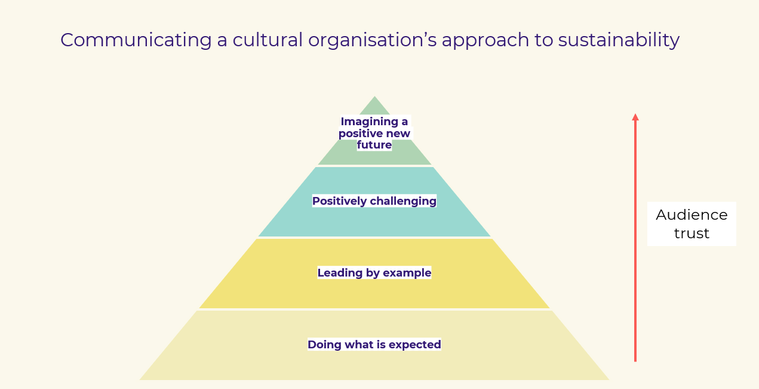In June, we attended the Association of Independent Museums Conference in Portsmouth and delivered an exclusive first look at Act Green 2024’s responses from museum visitors, comparing those to the wider dataset of cultural audiences.
Louise Sinclair, Head of Marketing, Communications and Audiences at Compton Verney, who took part in Act Green 2024, shared her reflections from their own results and explained how the findings have influenced various sustainability projects.

What is Act Green?
Our Act Green survey is an Indigo Share Hot Topic, a UK-wide audience research project designed to understand the attitudes of cultural visitors and audiences to the climate emergency. We have run this for three years in the UK, with the first Act Green Ireland currently taking place (Summer 2025). You can see all the results from past years in our Resources.
What do museum visitors expect us to be doing when it comes to tackling the climate emergency?
Museum and gallery visitors are even more concerned about the climate crisis than UK cultural audiences on the whole, with 91% saying they are worried. Crucially, 77% of these museum/gallery visitors think cultural organisations have the responsibility to influence society to make radical change to address the climate emergency.
- 61% of museum and gallery visitors say they expect organisations to be engaging with them and facilitating conversations
- 51% expect organisations to be tackling the subject of climate change through the artistic or curated programme.
- The majority of museum and gallery visitors expect organisations to be avoiding environmentally harmful cleaning products and procedures while 77% want to see the support of biodiversity prioritised.
- 65% expect organisations to share sustainability targets and achievements with them.
- 67% of museum visitors expect to be provided with information about how they can travel more sustainably to venues and 60% want to see discounts or incentives being offered to them for travelling more sustainably.
- As well as wanting to see the avoidance of single use plastic and disposable packaging, 88% of visitors expect organisations to be minimising food waste while more than half expect to see an increase of availability of plant-based options.
- 70% of museum visitors want to see organisations working with contractors and suppliers with similar values on environmental issues
- 56% want to see cultural organisations joining with others to lobby, campaign or influence.
How can museums communicate their sustainability efforts effectively?
We know it’s one thing to implement these initiatives, but it's another for museums to communicate them with visitors in a way that feels beneficial. Many already do a lot regarding the sustainability of their organisations, but may not be sure how to get the message across to visitors and engage them. Our suggested approach for engaging with visitors, building trust and highlighting ‘hero’ projects is through the communications pyramid:

Doing what is expected: At the most basic level you need to show and tell visitors that you’re doing what they expect of you. Provide infrastructure that they can use to help you. Recognise your existing efforts and celebrate them!
Leading by example: Here you could be starting to highlight ways in which you might be trying to do things differently. Perhaps a biodiversity project, or a new way to encourage people to travel to the venue.
Positively challenging: It’s very clear that visitors want to see us using our influence in society to help facilitate conversations and exploration around the climate emergency. This is perhaps where we start to get into the most sensitive territory around ‘facilitating’ rather than ‘preaching’. It is also where potentially we can use our collective voice to lobby for change on things that individually we can’t do anything about, like, for example, public transport.
Imaging a positive new future - embedding messages in our creative output: This is where your programmers and curators can help visitors imagine what a different future world might look like, and help people to see beyond the here and now.
Learning from others
It’s clear some organisations who have taken part in Act Green to date are finding meaningful ways to tell this story: fundraising campaigns focusing on sustainability initiatives, programmes of work directly addressing climate crisis issues or consistent messaging across retail, food and beverage outlets and artistic spaces.
To learn about real examples of sustainability projects from Compton Verney and reflections on how these have resonated (or not!) with their visitors, head over to their case study.